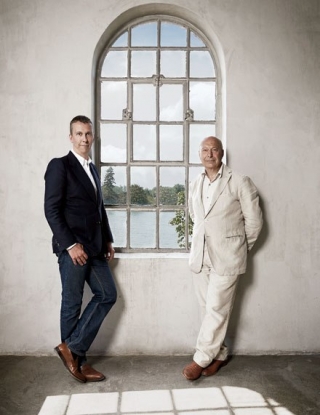Axel Vervoordt’s Design Philosophy
September 12, 2013 Filed under: The Buzz

Belgian designer and antiquarian Axel Vervoordt discusses his elemental aesthetic—highlighted in a forthcoming book—and the art
Architectural Digest:
We treasure things that are made by time,” says Axel Vervoordt, offering as good a summary as you’ll get of the antiques dealer and interior designer’s celebrated style—which favors muted tones, weathered surfaces, richly patinated antiques, and a mix of ancient and modern artworks that share abstract, universal qualities. Among the world’s most influential tastemakers, Vervoordt is fond of sagelike aphorisms. Another one: “There are no rules to what we do—it comes from the heart.”
Illustrating the importance of emotion, the Belgian maestro recounts his discovery of an Yves Klein fire painting he purchased this summer. “It touched me so deeply, I had tears in my eyes,” says Vervoordt, who buys, on average, 200 pieces of furniture and works of art per month. At present his inventory runs to a staggering 16,000 objects.
Whatever Vervoordt does, it tends to be on an impressive scale. He and his wife, May, own a palazzo on Venice’s Grand Canal and a chalet in Switzerland but live primarily at Kasteel van ’s-Gravenwezel, their Belgian castle surrounded by sprawling gardens and woodlands, near Antwerp. His firm, which now employs some 100 people, is headquartered at Kanaal, a waterside complex of industrial buildings in the Antwerp suburb of Wijnegem. The operation, managed by his sons, Dick and Boris, has three distinct divisions. Dick handles real-estate development, while Boris oversees the growing interior design department (35 employees, some 50 active projects) and the art and antiques business, which will be expanding with a new gallery in Hong Kong at the end of the year.
Increasingly Axel is taking a backseat role, spending time on curatorial activities. (“My father is much more of a mentor to the company,” affirms Boris.) But he is still directly involved in certain interior commissions, especially for high-profile clients like Robert De Niro, for whom Axel and architect Tatsuro Miki are crafting a penthouse atop New York’s Greenwich Hotel based on wabi-sabi principles of purity and simplicity.
Highlighting some of the firm’s finest recent work is the book Axel Vervoordt: Living with Light (Flammarion), due out in October. It features 17 interiors, most previously unpublished, including a house in Provence once owned by Picasso, a villa in Portugal’s Algarve region, and a pair of über-stylish yachts. “The book is all about windows, views, and fantastic light,” Axel says. It also emphasizes minimalist spaces where precedence is given to exquisite compositions of sculptural furnishings and art.
The last chapter is on Kanaal, which in the 19th century was the largest distillery in Europe. Currently the Vervoordts are overseeing a $130 million project on the site, creating 100 apartments—some inside six towering former silos—the first of which will be ready next fall. Kanaal will also be home to the Axel and May Vervoordt Foundation’s planned 54,000-square-foot museum, tentatively slated to open in 2017.
For now, the foundation is focused on staging exhibitions, including one at the Palazzo Fortuny in Venice (through November 24) devoted to the late Spanish painter Antoni Tàpies—an artist Axel believes is underappreciated and undervalued. And the designer is devising the next installment of an influential series of thematic exhibitions he began in 2007 with “Artempo.” Planned for 2015, the show will be about proportion, a subject he is busy analyzing along with a think tank of scientists, musicians, artists, and philosophers.
In the meantime the Vervoordts continue to make acquisitions for the foundation, ranging from an early-Cycladic head more than 4,000 years old to a 15th-century Thai Buddha hand to postwar works by artists from the Zero group in Europe and the Gutai movement in Japan. “I’ve always looked for what’s universal in art, what’s timeless,” asserts Axel, citing Kazuo Shiraga, Lucio Fontana, Günther Uecker, Jef Verheyen, James Turrell, and Anish Kapoor as a few favorites. A recent find is the Gutai artist Norio Imai.
Boris notes that art has become a more prominent part of the company’s work, as his team often plays a curatorial role for clients—though it’s not in the business of scouting up-and-coming talent. “Our mission isn’t to find cutting-edge creations by 21-year-old kids,” he says. “We are coming from a spectrum that spans from ancient Egypt to today. We prefer to look at artists where we can already feel a career, a vision.”
“Through art, we make clients discover things they didn’t know before,” adds Axel. “But once they discover it, it’s like they’ve known it forever.” axel-vervoordt.com